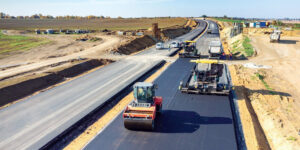More and more alternative and green materials would be utilised for highway construction in future.
DR. ABHISHEK MITTAL, Principal Scientist and HoD, Flexible Pavements Division CSIR-Central Road Research Institute (CSIR-CRRI) What is your overview on the current scenario of Indian roads and highways sector? The road sector in India has seen significant growth and development in recent years, with the government investing heavily in infrastructure projects to improve connectivity and

DR. ABHISHEK MITTAL,
Principal Scientist and HoD, Flexible Pavements Division
CSIR-Central Road Research Institute (CSIR-CRRI)
What is your overview on the current scenario of Indian roads and highways sector?
The road sector in India has seen significant growth and development in recent years, with the government investing heavily in infrastructure projects to improve connectivity and support economic growth. India has the second largest road network in the world, with a total length of approx. 6.4 million kilometers. The total length of national highways is presently 1.45 lakh kilometers (MORTH, 2023). There has been a significant thrust towards highway construction with MORTH and NHAI setting up an ambitious target of construction of 14,000 km of national highways in the FY 2023-24. For this, the Union Budget provided an allocation of 2.7 lakh crore for FY 2023-24, which is 36% higher compared to the previous year allocation. The focus of the government is towards the development of highways in the country and appropriate steps are also being taken in right earnest.
On the implementation side, there have been significant efforts from MORTH to promote the use of new and sustainable materials and technologies into the highway construction. Some recent MORTH circulars regarding adoption of value engineering practices in design, construction and maintenance of highway projects, reuse of materials reclaimed from existing pavement layers, mandatory use of plastic waste in wearing coat of service roads and slip roads throughout national highways provide a clear indication about the government's intent to make the highways of the country world class and sustainable.
However, there are some definite challenges which the Indian road sector is facing, including land acquisition, project execution delays, road safety and environmental concerns. Efforts are on to address these issues, but I would say that more concrete efforts are needed to tackle these issues.
From an overall perspective, it is clear that the government's continued investment towards the infrastructure development will lead to significant growth and improvement in the coming years.
Considering the way projects are taking off, there is a need to scale up the efficiencies and capabilities of contractors and others takeholders involved in the projects. How do you look at this and what kind of strategy are needed in this direction?
To improve the efficiencies of contractors and other stakeholders in the highway sector, a multi-faceted approach involving several strategies is needed. Some ways to scale up the efficiencies in the highway sector are:
• Capacity building and training: Capacity building and training programs may help to equip the contractors and stakeholders with the necessary skills and knowledge to perform their roles efficiently and effectively. Training programs may include areas such as project management, construction and quality control aspects, risk management, to name a few.
• Technology adoption: Contractors and stakeholders in highway sector can leverage technology to improve the efficiency in several ways. Use of drones for mapping and surveying can significantly reduce time and cost of project execution. Also, use of project management software, digital twin, GPS-based tracking systems can help in real-time monitoring and optimization of the project.
• Performance-based contracts: Such contracts can incentivize contractors to complete projects on time and within budget. Under such contracts, contractors are rewarded for meeting or exceeding pre-defined performance targets. The present contracts incentivize the contractors for delivering on time, not on performance.
How are you contributing to the road infrastructure development of the country?
CSIR-Central Road Research Institute (CSIR-CRRI) is a premier national research organisation for roads, highways, traffic and transport and all other allied aspects. It carries out R&D in the area of road transportation and provides highest level of professional consultancy.
As part of CSIR-CRRI, we have been working towards various projects related to flexible pavements and providing solutions for real and challenging field problems to different agencies. CSIR-CRRI is involved in research and development in areas related to roads and highways. Pavement recycling, full depth reclamation (FDR), use of waste plastic, stabilization, cement grouted bituminous macadam (CGBM), processed steel slag aggregates for road construction are some of the research outcomes which have been successfully implemented. These research outcomes have also been utilized for the formulation of many new IRC guidelines and specifications. CSIR-CRRI is also involved in training and capacity building programs for engineers and professionals in the road sector. These programs help to enhance the skills and knowledge of engineers, thereby improving the quality of road infrastructure.
Sustainability plays a major role in the current construction practices. What are the sustainability practices being adopted in roads and highways construction?
The UN commission defined sustainability as 'meeting the needs of the present without compromising the ability of future generations to meet their own needs'. The goal of sustainability is to make the world suitable for future generations. The sustainability concept integrates the economic, societal and environmental aspects.
Highway construction and maintenance consume a lot of fossil energy in mining, transportation and paving works, and causes air and noise pollution, by the very nature of the activities involved. For sustainability in roads and highways sector, one needs to look for materials, design, construction and maintenance aspects for the road pavements.
It is well known that significant energy consumption and emissions generation takes place during the acquisition, processing and transportation of materials during the construction phase of pavements. Reducing dependency on virgin materials by adopting local and marginal materials, industrial by-products such as slag, recycling the materials and adopting better mix design practices are some of the options being explored during the highway construction. Cold mix technology, use of warm mix additives, pavement recycling, full depth reclamation, and use of processed steel slag aggregates are some of the technologies leading to sustainability in the highway construction.
What are the new-age technologies employed in roads and highways construction?
Apart from the use of sustainable materials in the highway construction, there has been a significant usage of digital technology in the road sector. Use of 3-D printing technology, smart materials, mobile mapping, and intelligent compaction are few technologies being employed in the road sector.
3-D printing technology is being used to manufacture bridge components and other infrastructure elements. This technology has the potential to significantly reduce the time and cost of construction, while also allowing for greater design flexibility.
Smart materials are materials that have the ability to change their physical properties in response to external stimuli. These materials are being used in the construction of smart roads that can adapt to changing traffic conditions and weather.
Mobile mapping technology uses vehicles equipped with sensors and cameras to create detailed 3D maps of road networks. These maps can be used for various applications, including road maintenance, traffic management, and infrastructure planning.
Intelligent compaction (IC), as per FHWA, refers to improved compaction process using rollers equipped with an integrated measurement system that consists of accelerometers, an onboard computer reporting system, infrared thermometers, GPS-based mapping, and optional feedback control. IC allows for real-time monitoring and timely adjustments in the compaction process. IC helps in achieving uniform densities and thereby helps in improving the performance of road pavements.
Some countries are also using Artificial intelligence (AI) for mapping and digitizing their road assets. AI-enabled compute vision models can identify road damage and report road condition to the authorities, and create heat maps. This helps the authorities to take timely and appropriate action.
What is your outlook on the Indian roads & highways sector? What could be the major trends to look for in future?
As I said in response to the first question, the current scenario is Indian road sector looks very promising and the future outlook is also very bright. The government is clearly focussed on infrastructure development to bring growth of the country. With the seamless adoption of the latest technological advancements, the Indian road sector is rapidly evolving and several trends are emerging that are likely to shape its future. Some of the key trends, in my view, to look for in future include sustainability, use of data analytics and AI.
It is utmost important that the materials and technologies being used for highway construction are sustainable. We can't keep on exploiting the mother earth for the needed resources. In the words of Mahatma Gandhi, “The Earth has enough resources to meet the needs of all but not enough to satisfy the greed of even one person”. In other words, the development and resource utilization has to go hand in hand. So, more and more alternative and green materials would be utilized for highway construction in the coming years.
With the improvement in the data analytics capabilities and Artificial Intelligence, smart materials, smart infrastructure, better maintenance decisions, and digitization of infrastructure assets have been possible and will continue in future also.

Hits: 14












